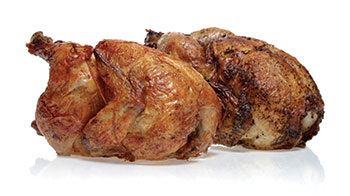One of the biggest benefits of rotisseries is that customers can see product cooking, which promotes the theater experience and may help increase revenue.
 Foodservice operators use these units in both the back and the front of the house to roast skewered meats and poultry, most often whole chickens. Operators can also cook turkey breast and fish, along with potatoes and other vegetables, in a rotisserie. Some operators also use this method to cook barbecue items, such as ribs, pork and beef brisket.
Foodservice operators use these units in both the back and the front of the house to roast skewered meats and poultry, most often whole chickens. Operators can also cook turkey breast and fish, along with potatoes and other vegetables, in a rotisserie. Some operators also use this method to cook barbecue items, such as ribs, pork and beef brisket.
Rotisseries operate using a small electric motor that rotates product on a spit as moist, hot air circulates around foods and throughout the unit’s cavity. This rotation helps facilitate self-basting, while the equipment’s process and temperature create caramelization.
Operators can choose from countertop, see-thru and pass-thru models. To accommodate smaller footprints, operators can opt to stack some units, while others offer wall-mounting capabilities.
Commercial rotisserie models offer batch- or continuous-cooking units. Operations serving high volumes of customers during specific time frames, such as in schools or at banquets, may opt for a batch unit. These units may be a good fit for operations that hold food items throughout the day.
Rotisserie sizes can range from 15 inches high by 35 inches deep by 37 inches wide for a countertop unit to 78 inches high by 37 inches deep by 42 inches wide for high-volume batch machines. Unit capacities range from 150 to 2,000 pounds, with most full-size units accommodating between 35 and 80 whole chickens.
Today’s rotisseries feature space-saving designs. One large unit will not cook as much product as two smaller ovens, and separate units will also allow an operator to cook two different products at the same time. In addition, utilizing two ovens will allow operators to stagger cooking times as needed or desired.
For operations with varying volume requirements, rotisseries that have more than one cavity or stacked units can better accommodate slow periods. Stacked ovens also allow operators to produce more product in a smaller footprint, which saves floor space.
Most rotisserie cabinets feature a galvanized sheet metal body with an interior and exterior made of stainless steel. Door types range from single, front-pivoting designs to double closures with either glass fronts or windows. Models with a curved glass design enhance customer viewing in front-of-house settings.
Most electric units will run on 208 volts and 30 to 40 amps, but many can run on 240 and 480 amps as well. Electric models that provide a combination of convection and ceramic radiant heat are available. Some gas units provide an electronic ignition.
Some rotisseries include standard rear fireplace burners with ceramic logs to simulate an open hearth. Heat emanates from infrared sources or the circulation of warmed air.
Gas rotisseries tend to be larger and have longer spits than electric units. Although these types will have a larger capacity, operators need to consider that gas units will be heavier to load and may be more difficult to clean. Gas models that use a combination of wood and infrared gas burners/generators present operators another option. Some units generate heat from above, while others heat from below.
Rotisserie accessories and options include heavy-duty spits and baskets to hold fish or vegetables. Ovens with horizontal spits allow the co-mingling of various menu items. Rotisseries may also include warming cabinets to hold finished products. Some doors are designed to stay cool for added safety.
Other available options include touch-screen operation, automatic cleaning programs, USB capabilities for HACCP data collection, adjustable legs, electric timers, mirrored door glass, and coated angled or piercing spits.
Operators have the option of choosing from a number of energy-efficient rotisserie features. For example, batch units with forced-air burners create a higher velocity of oxygen and gas, which can provide as much as 35 percent energy savings.
Newer spit designs include gas heat that cooks food from the inside out. This not only helps kill bacteria but can also increase yield and shorten cooking times. With some units, a self-cleaning feature will help keep convection fans clean, which can decrease cooking times and provide energy savings.



